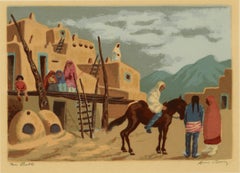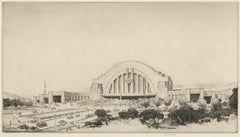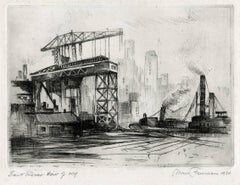Want more images or videos?
Request additional images or videos from the seller
1 of 8
Anna BarryTaos Puebloc. 1945
c. 1945
Price:$340
$400List Price
About the Item
- Creator:Anna Barry (1907 - 2001)
- Creation Year:c. 1945
- Dimensions:Height: 4.88 in (12.4 cm)Width: 7.13 in (18.12 cm)
- Medium:
- Movement & Style:
- Period:
- Condition:
- Gallery Location:Fairlawn, OH
- Reference Number:Seller: FA63101stDibs: LU14015733222
About the Seller
5.0
Recognized Seller
These prestigious sellers are industry leaders and represent the highest echelon for item quality and design.
Platinum Seller
Premium sellers with a 4.7+ rating and 24-hour response times
Established in 1978
1stDibs seller since 2013
815 sales on 1stDibs
Associations
International Fine Print Dealers Association
Authenticity Guarantee
In the unlikely event there’s an issue with an item’s authenticity, contact us within 1 year for a full refund. DetailsMoney-Back Guarantee
If your item is not as described, is damaged in transit, or does not arrive, contact us within 7 days for a full refund. Details24-Hour Cancellation
You have a 24-hour grace period in which to reconsider your purchase, with no questions asked.Vetted Professional Sellers
Our world-class sellers must adhere to strict standards for service and quality, maintaining the integrity of our listings.Price-Match Guarantee
If you find that a seller listed the same item for a lower price elsewhere, we’ll match it.Trusted Global Delivery
Our best-in-class carrier network provides specialized shipping options worldwide, including custom delivery.You May Also Like
DISCOVERY OF GOLD - Very Large Serigraph - WPA Artist - California Murals
By Anton Refregier
Located in Santa Monica, CA
ANTON REFREGIER (1905 – 1979)
DISCOVERY OF GOLD, 1949. Color serigraph. Signed and numbered in pencil, edition of 90. Image 23 ¼ x 21 ¾" Large sheet, 29 3/4 x 25 ¼”. Printed title...
Category
1940s American Modern Figurative Prints
Materials
Screen
$1,250
H 23.5 in W 21.75 in
"Skiing Near Holy Hill, " Original Silkscreen Landscape by Schomer Lichtner
By Schomer Lichtner
Located in Milwaukee, WI
"Skiing Near Holy Hill" is an original silkscreen print by Schomer Lichtner. The artist initials are lower right, and the title is along the lower edge. This print depicts people skiing near Holy Hill, Wisconsin. The artist used a muted blue, a deep and dark purple, and accents of red to create this piece.
4 7/8" x 6 7/8" art
11 7/8" x 13 7/8" frame
Milwaukee artist, Schomer Lichtner passed away on May 9, 2006 at the age of 101. He continued to amaze and create with his whimsical paintings of ballerinas and cows. He and his late wife Ruth Grotenrath, both well-known Wisconsin artists, began their prolific careers as muralists for WPA projects, primarily post offices.
Schomer Lichtner was well known for his whimsical cows and ballerinas, such as his "Ballerina Dancing on Cow" sculpture below. The late James Auer, art critic for the Milwaukee Journal Sentinel referred to Lichtner as the artist laureate of Milwaukee, Wisconsin. He was the official artist of the Milwaukee Ballet.
Lichtner also painted murals for industry and private clients. Schomer was a printmaker and produced block prints, lithographs, and serigraph prints. His casein (paint made from dairy products) and acrylic paintings are of the rural Wisconsin landscape and farm animals. He became interested in cows when he and Ruth spent summers near Holy Hill in Washington County.
According to David Gordon, director of the Milwaukee Art Museum, Schomer Lichtner had a tremendous joie de vivre, " joy of life," and expressed it in his art.
Schomer Lichtner was nationally known for his whimsical paintings and sculptures of black- and white-patterned Holstein cows and elegant ballerina dancers. Lichtner also painted all sorts of combinations of beautiful women, flowers and country landscapes. James Auer, former Milwaukee Journal Sentinel art critic, said that his art eventually "exploded into expressionistic design elements with bold, flat areas of color and high energy that anticipated Pop Art." Auer went on to describe Lichtner’s work as full of "wit, vigor and virtuosity."
As early as 1930, Lichtner’s work was shown at the prestigious Carnegie International Exhibition in New York and at museums throughout the Midwest. As a student, he was a protégé of another icon of 20th century American art, Gustave Moeller...
Category
1940s American Modern Landscape Prints
Materials
Screen
Schomer Lichtner"Skiing Near Holy Hill, " Original Silkscreen Landscape by Schomer Lichtner, c. 1947
$2,430
H 11.875 in W 13.875 in
Road to Horizon original limited edition serigraph by Chase Chen
By Chase Chen
Located in Paonia, CO
Road To Horizon by Chinese/American artist Chase Chen depicts a hillside with a road that leads up to some trees on the top of the hill silhouetted against a blue sky and scattered clouds perhaps at sunset. Original limited edition [ 346/350 ] serigraph signed in pencil and in very good condition with two small creases in the outer margins on the lower left. Paper size 29.50 x 35.25 image 24 x 30.50.
Born into a family of doctors and growing up during the cultural revolution Chinese...
Category
1990s American Modern Landscape Prints
Materials
Screen
$3,500
H 29.5 in W 35.25 in
Lost Shadow original limited edition serigraph by Chase Chen
By Chase Chen
Located in Paonia, CO
Lost Shadow by Chinese American artist Chase Chen depicts a country path that follows a receding fence line in a green field and a blue sky filled with scattered clouds. A limited edition [345/350] signed serigraph in excellent condition.
Paper size 36 x 29 image 30.50 x 24.
Born into a family of doctors and growing up during the cultural revolution Chinese...
Category
20th Century American Modern Landscape Prints
Materials
Screen
$3,500
H 36 in W 29 in
Bird House original limited edition serigraph by Chase Chen
By Chase Chen
Located in Paonia, CO
Bird House by Chinese/American artist Chase Chen depicts a barn on a hillside with birds flying into the sky from the roof and a small stream or irrigation ditch flowing downhill and a water pail sitting in the field. There is a blue above the hill. A limited edition [124/350] serigraph created in the year 2000, signed in pencil and in very good condition. Paper size 30.25 x 38.75 image 25 x 33.25.
Born into a family of doctors and growing up during the cultural revolution Chinese...
Category
Early 2000s American Modern Landscape Prints
Materials
Screen
$3,500
H 30.25 in W 38.75 in
'The French Farm' — Mid-Century Modernism
By Edward August Landon
Located in Myrtle Beach, SC
Edward Landon, 'The French Farm', color serigraph, 1942, Ryan 86. Signed, titled, and annotated 'Edition 50' in pencil. A superb impression, with fresh colors, on cream, wove paper; ...
Category
Mid-20th Century American Modern Landscape Prints
Materials
Screen
Los Banos
By Virgil Trasher
Located in San Francisco, CA
This artwork titled "Los Banos" 1969 in an original color serigraph by American artist Virgil Trasher b.1943. It is hand signed, dated and titled in pe...
Category
Late 20th Century American Modern Landscape Prints
Materials
Screen
Lake Summit
By Virgil Trasher
Located in San Francisco, CA
This artwork titled "Lake Summit" 1987 in an original color serigraph by American artist Virgil Trasher b.1943. It is hand signed, dated and titled in pencil by the artist. The image size is 14 x 25 inches, sheet size is 22.5 x 27 inches. It is in excellent condition.
About the artist:
Virgil Thrasher...
Category
Late 20th Century American Modern Landscape Prints
Materials
Screen
East Cove
By Virgil Trasher
Located in San Francisco, CA
This artwork titled "East Cove" 1987 in an original color serigraph by American artist Virgil Trasher b.1943. It is hand signed, inscribed A.P and titl...
Category
Late 20th Century American Modern Landscape Prints
Materials
Screen
Pair of serigraphs, Twin Lake and Lake View
By Virgil Trasher
Located in San Francisco, CA
These artwork titled "Twin Lake and Lake view" 1986 are two original color serigraphs on different papers by American artist Virgil Trasher b.1943. One is ...
Category
Late 20th Century American Modern Landscape Prints
Materials
Screen
More From This Seller
View AllTaos Pueblo
By Anna Barry
Located in Fairlawn, OH
Taos Pueblo
Screen print in colors, c. 1945
Signed and titled in pencil by the artist
Printed in Taos
Taos is the oldest continually inhabited city/village in North America.
How old ...
Category
1940s American Modern Landscape Prints
Materials
Screen
Cincinnati Union Terminal, Perspective From East
By Louis Conrad Rosenberg
Located in Fairlawn, OH
Cincinnati Union Terminal, Perspective From East
Drypoint, 1930-1931
Signed in pencil lower right (see photo)
Initialed and dated the the plate above the pencil signature
From: Cincinnati Series (8 Plates), this No. 2
Edition: 155, completed May 4, 1931
Delivered to Fellheimer & Wagner, 1931
Louis Conrad Rosenberg
1890-1983
An American architectural etcher and engraver of the 1920's and 1930's era, Louis Conrad Rosenberg first studied at the Massachusetts Institute of Technology...
Category
1930s American Modern Landscape Prints
Materials
Drypoint
East River View of N.Y.
By Mark Freeman
Located in Fairlawn, OH
East River View of N.Y.
Etching, 1934
Signed, dated and titled in pencil by the artist
From a very small edition.
Brilliant impression
Condition: Excellent
Image/Plate size: 5-1/8 x...
Category
1930s American Modern Landscape Prints
Materials
Etching
River Reflections
By Arthur Wesley Dow
Located in Fairlawn, OH
River Reflections
Color woodcut, c. 1910
Unsigned
Provenance: Dow Family Album, Cincinnati
Condition: Excellent
Image size: 2 1/2 x 4 inches
Sheet size: 3 1/8 x 4 7/8”
A color varian...
Category
1910s American Modern Landscape Prints
Materials
Woodcut
7th Avenue Canyon
By Anton Schutz
Located in Fairlawn, OH
7th Avenue Canyon
Etching, 1927
Signed and titled in pencil by the artist (see photo)
Depicts what was then referred to s the Garment Disctrict in New York City.
References And Exhib...
Category
1920s American Modern Landscape Prints
Materials
Etching
Ancient Landscape II (Ancient City)
By Louise Nevelson
Located in Fairlawn, OH
Ancient Landscape II (Ancient City)
Etching and drypoint, 1953-55
Signed and titled in pencil by the artist (see photos)
Annotated: "E130 A/1" in pencil lower right
Estate stamp vers...
Category
1950s American Modern Landscape Prints
Materials
Drypoint



